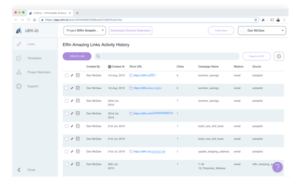

- Utm campaign builder how to#
- Utm campaign builder code#
- Utm campaign builder Offline#
- Utm campaign builder plus#
Utm campaign builder Offline#
This could be Facebook, Google, another website, and even offline referrers like flyers, one-pagers, and brochures. Use it for : This is the main UTM you’ll need, which identifies the referrer that sent a user to your site.
Utm campaign builder how to#
If you go this route, here are the parameters you’ll need, with examples of how to use each: UTM Source You can use letters and numbers, but spaces aren’t allowed.
Utm campaign builder plus#
When you name each of your UTMs, the only symbols you can use are the plus sign (“+”) and the period. Note that you can also generate UTMs manually, without using the builder tool.
Google will generate a URL containing your UTM code, which you can now copy and convert into a shortlink using your own favorite tool - or have Google convert into a shortlink right there within the builder.Ĭreating UTMs Without the Google URL Builder If applicable, enter the medium, name, content, and search term (if you’re doing a PPC campaign).If possible, use the HTTPS version to avoid users seeing that pesky “Not Secure” warning in their browsers. Enter the URL of the landing page or destination page for your marketing campaign.Here are the steps to creating a UTM for your website or landing page: If you want to create UTMs for other destinations (apps in the Google Play Store or Apple Apps), you’ll need to visit those respective builders. If you’re generating a UTM for a marketing campaign webpage, start by opening Google’s URL builder. Content: Which specific link drove them thereįrom there, you can take that information and determine which elements of your campaign are working, where people are coming from, which links they’re clicking, and why they’re showing up to learn more.Term: If it’s a PPC campaign, which search term brought them there.Campaign: The campaign name that referred them.Medium: What marketing tactic drove them there (social, blog, affiliate).Source: Where the user came from (social platform, website, or offline piece of content).The UTM within the link, however, reports back to Google Analytics with up to five unique pieces of information: So you place unique “vanity URLs” within each of these items – the brochure, the flyer, and the ad campaign – for your customer to follow.Įach URL redirects to the same place, your landing page or website, so all of the leads from your campaign are seeing the same awesome content. Imagine you’ve created a fantastic landing page for your product, and now you want to drive traffic to this landing page from several different places: a brochure you’re handing out at events, a flyer you’ll be putting up at college campuses, and a Facebook ad campaign.
Utm campaign builder code#
A UTM is a piece of code within a URL that tells Google Analytics where a site visitor came from, online or offline. There’s no better way to accelerate growth and prove your worth month after month.īy the end of this post, you’ll be able to start using UTMs in your marketing campaigns to zoom in on what’s working in your marketing and what’s not. With UTM codes, you can segment your online traffic and report back to your leadership team or clients with hard data on the return on investment you’re getting for your marketing spend. For digital marketers, tracking the source of your leads and customers is vital to discovering your most effective, most efficient lead channels.


 0 kommentar(er)
0 kommentar(er)
